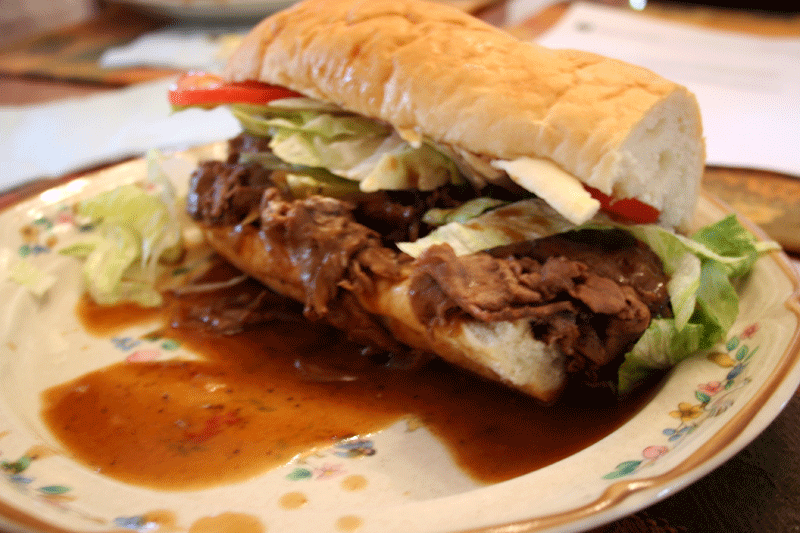 Monique went to New Orleans and Baton Rouge this past weekend to visit with family and attend her sisters baby shower, and it was a surprise visit for most of them on Sunday. But on Saturday she wanted to get some local eats while on the whirlwind tour and ended up at a place called Cocodrie’s and ate a “Peace Maker” where Fried Shrimps & Fried Oysters are combined to form one of the best po-boy’s around. When I told Ben about her lunch his jaw just dropped, and then he started talking about the last time I had made some Hot Roast Beef po-boy’s at home.
Monique went to New Orleans and Baton Rouge this past weekend to visit with family and attend her sisters baby shower, and it was a surprise visit for most of them on Sunday. But on Saturday she wanted to get some local eats while on the whirlwind tour and ended up at a place called Cocodrie’s and ate a “Peace Maker” where Fried Shrimps & Fried Oysters are combined to form one of the best po-boy’s around. When I told Ben about her lunch his jaw just dropped, and then he started talking about the last time I had made some Hot Roast Beef po-boy’s at home.
To appease Ben’s taste for good ole N’Awlins flavor, I ventured out to the grocery late Sunday morning and I bought a pound of thin sliced rare roast beef, a loaf of French bread and some Iceberg lettuce and tomatos for what would be his lunch treat at half-time while we watched the Saints game on CBS.
Now in other parts of the world a po-boy might be known as a sub, grinder, or hero, but what really sets it apart from all the other sandwiches is that the bread is a crusty French bread loaf. In southeast Louisiana the best store bought brand of French bread for po-boy’s is Reising’s from Leidenheimers bakery. The crusty outside combined with the light and airy inside make Reising’s French bread the best all around in New Orleans.
A Lesson in Po-Boy History
During the early years of the 20th century, two brothers, Benny and Clovis Martin, migrated to New Orleans from rural Raceland, Louisiana. When the Martins first reached the city, they found employment as streetcar conductors. Later, they opened a sandwich shop near the French Market and made a culinary discovery: if they concocted sandwiches out of the traditional loaf of French bread, with its tapered ends, the resulting sandwiches would vary in size. The solution was relatively simple: the modern, more or less symmetrical po-boy loaf, which could be cut into equal size sandwiches.
As for the name, during the late 1920’s, the New Orleans streetcar conductors went on strike. The Martins vowed to feed their striking brethren for free. When one of the strikers entered their shop, the call went out: “Here comes anther po-boy!”
The ingredients that go into a po-boy are virtually limitless, depending on one’s imagination: hot roast beef with gravy, ham and cheese (known in New Orleans as a “combination”), fried seafood (oysters, shrimp, softshell crabs, catfish), hot sausage, meatballs–even French fries, yup, a French Fry po-boy can be had at most corner grocery store deli’s around the city. And the counter sandwich maker typically will ask you… “and do you want that dressed?” When the New Orleans po-boy is “dressed,” the reference has nothing to do with fashion: “dressed” in New Orleans nomenclature means that lettuce, tomatoes, and mayonnaise are added, and pickles too on some! Nothing fills you up quick and easy like a fresh hot po-boy made with fresh French bread.
Hot Roast Beef Po-Boy
| Ingredients | |||
| 1 | lb. | Roast beef, thin sliced | |
| 2 | Each | Tomatoes, sliced thin | |
| ¼ | Head | Iceberg lettuce, shredded | |
| ½ | Cup | Mayonnaise (Recommend Blue Plate brand ) | |
| 12 | Slices | Pickles | |
| 1 | Loaf | French bread (Recommend Leidenheimer’s brand) | |
| Gravy Ingredients | |||
| ½ | Cup | Onions, small diced | |
| 2 | Cups | Beef stock | |
| ¼ | Cup | Dark roux | |
| 1 | Tbsp | Worcestershire sauce | |
| 1 | Tbsp | A1 Steak sauce | |
| Preparation Steps | |||
| 1. | For the gravy sweat down the onions in a little olive oil then add the beef stock and bring to a boil. Add the roux and whisk well until smooth. Add Worcestershire and steak sauce stirring well. Simmer 20 minutes. Then add the thin sliced roast beef and allow to heat through. | ||
| 2. | Quarter the French bread in 4 even pieces, and slice each piece ¾ of the way without cutting through. | ||
| 3. | Spread mayonnaise evenly inside the French bread then layer the top side with sliced pickles, sliced tomatoes, and lastly with the shredded lettuce. | ||
| 4. | On the bottom half gently and evenly lay the roast beef then ladle some of the hot gravy on top of the beef. Fold the top half over onto the bottom half and enjoy with a cold drink or frosty mug of brew. | ||













11 responses so far ↓
1 Frank // Oct 29, 2008 at 10:26 am
All due respect, Ryan, the Martin Brothers are the originators of the “Poor Boy” sandwiches. The term po-boy came much later.
Also the Peacemaker is a loaf of French bread, split and buttered and filled with fried oysters, no “Fried Shrimps”.
2 Ryan Boudreaux // Oct 29, 2008 at 11:43 am
Oh hey Frank! Long time no comment! Oh okay…”Poor Boy, po-boy, semantics huh! They all taste the same to me, no matter how you spell or say it!
The Peacemaker po-boy was a favorite of mine at the ole Streetcar Po-Boy shop on Carollton that closed up many years ago, and it was a 1/2 shrimp and 1/2 oyster loaf. I got mine “dressed” too!
Culinarily yours,
CCR =:~)
3 Ryan Boudreaux // Oct 29, 2008 at 11:59 am
I did some more digging and I found a current recipe online for the Peacemaker Po-boy from Food Network that comes from the Acme Oyster House.
Title: The Peacemaker: Golden Fried Oyster and Shrimp Po-Boy with Hot Sauce-infused Mayonnaise, Lettuce, and Tomato
Source: Recipe courtesy Acme Oyster House, New Orleans, LA
Show: The Best Of, Episode: State Plates
See: http://www.acmeoyster.com/#poboys
4 Frank // Oct 29, 2008 at 4:42 pm
La Médiatrice, or “the peacemaker,” was the name given the oyster loaf in New Orleans in the 1800s. The James Beard Foundation, on its website, explains:
“Men out late carousing in the French Quarter brought home the golden toasted loaf, hollowed out and stuffed with hot creamed oysters or perhaps buttery fried oysters, as a peace offering to their jealous wives. The loaves were sold all over the Quarter for pennies. In 19th-century oyster-crazed America, the loaf was known elsewhere too. The original Joy of Cooking (1931) includes a recipe, although by then the loaf had metamorphosed into Creamed Oysters in Bread Cases, which sounds better suited to a ladies’ lunch than to making marital amends.”
5 Ryan Boudreaux // Oct 29, 2008 at 5:30 pm
How about that! Nice piece of po-boy history I did not know! And just goes to show you how a dish can evolve over time and culture. Thanks!
6 Frank // Oct 29, 2008 at 5:45 pm
Anyway enjoy your poor boys or po’boys. When I was on the NOPD in the 60’s I had a partner that would say “It’s just a matter of ‘ceramics’. ”
I personally enjoy the Ferdi Special; dressed with debris at Mother’s.
7 Ryan Boudreaux // Oct 30, 2008 at 8:52 am
Yup! Nothing beats the Ferdi at Mother’s! Jerry Amato has done a great job with keeping the original menu over the years. I also like the way that they use shredded cabbage in place of lettuce for their “dressed” po-boys!
8 Frank // Nov 17, 2008 at 1:45 pm
Here’s a link to the Po-Boy Festival in New Orleans:
http://www.poboyfest.com/food
9 amanda // May 16, 2009 at 11:30 am
I have been trying to find the “perfect” poboy and I’ve decided that a tiny, little place (just about standing room only) bayouside in Houma called Roby’s Poboy has the best so far. They are currently rebuilding due to hurricane Gustav, but will hopefully be up and running soon.
10 dana // Sep 1, 2009 at 12:44 pm
Yes Amanda is right!!! Roby’s Po-boys in Houma has the BEST po-boys! If you are down that way, try the roast beeft. It rocks!
11 Rocky Garcia // Oct 23, 2009 at 3:55 am
Another must try recipe! I’m curious about the taste of this.